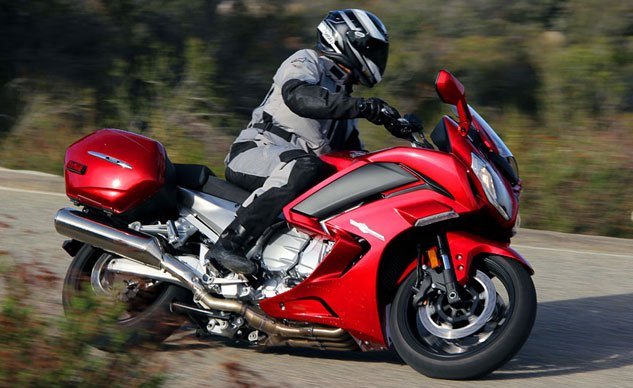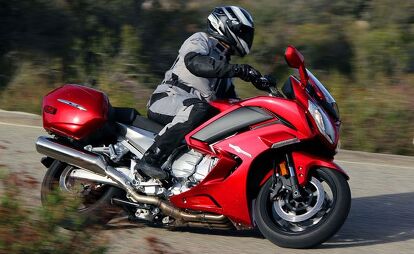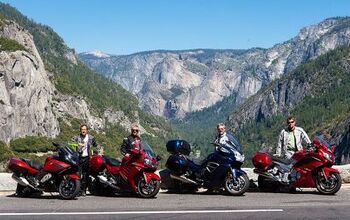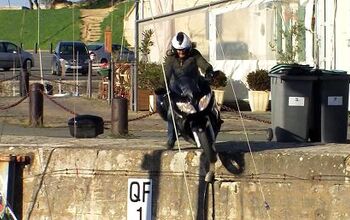2014 Yamaha FJR1300ES Review + Video

Better living through modern electronics
The first time you roll on the FJR1300ES’s throttle with a stretch of open road in front of you, you realize why it’s so popular with the long-distance riding set. The previous generations of the big Yamaha gobbled up pavement like a coed facing a tube of cookie dough just hours after a difficult breakup. Simply put, the FJR consumes both asphalt and gasoline, not stopping until you run out of one of them and then impatiently waits while you remedy the situation. Perhaps this is why Yamaha has left the FJR1300 largely unchanged over its lifespan, despite recent inroads into its market from other manufacturers. Whether you spell Supersport Touring with two or three words, the class is highly competitive where more than just having the highest horsepower or sharpest handling determines the victor.
2014 Yamaha FJR1300ES
| Engine | 19/20 |
| Suspension/Handling | 14.25/15 |
| Transmission/Clutch | 8.5/10 |
| Brakes | 8.75/10 |
| Instruments/Controls | 4.25/5 |
| Ergonomics/Comfort | 9/10 |
| Appearance/Quality | 9.25/10 |
| Desirability | 7.75/10 |
| Value | 9/10 |
| Overall Score | 89.75/100 |
Last year, the FJR1300A trounced the competition in our 2013 Sport-Touring Shootout 1.0, and those competitors entered 2014 without major changes. So, despite having a dominant and popular sport tourer, Yamaha stepped up to make a change to address what is perhaps the most frequent request from FJR fans: a firmer suspension.
Before we discuss the importance of the upgraded suspension, we should take a look at what made the FJR such a formidable opponent in 2013. The 1298cc inline-Four’s power delivery is controlled by R-b-W in the form of Yamaha’s Chip Controlled Throttle (YCC-T), which means that, while you’re in control of the grip, the butterflies are modulated by the depth of Yamaha’s knowledge about fuel injection. This translates into a responsive engine that feeds out torque from the bottom end right up to redline. The numbers sound good but feel even better with (according to our trip to the dyno with the mechanically identical 1300A last year) more than 60 ft-lbs available from 2000 rpm on up to its 88.8 ft-lbs peak at 6800 rpm. Horsepower checks in at 127.2 hp at 8100 rpm. These are more than enough to motivate the admittedly heavy FJR and two full-sized humans smartly.
Resident sportbike guy, Troy Siahaan, asserted, “The 1300 may not have the biggest engine in the class, but I’m certainly not left wanting for more,” a sentiment with which I heartily concur. In almost every situation, I was able to romp with plenty of throttle to spare. A sport-touring bike – even a supersport-touring bike – has long been considered a mount for old guys who want to go fast comfortably (as I stare down the barrel of my 52nd birthday in the next few days, the description is starting to get too close for comfort), but around town, the heart of a hooligan beats under the Yamaha’s full fairing and hard bags.
In fact, I had to puzzle over the grumbles I’d heard about the FJR lacking something because it didn’t have a sixth gear. Really? I can’t count how many times I looked down to see the number 95 where I thought 80 should be. Are the complaints just gear envy? I don’t know, but Troy felt the same disconnect when riding versus being a spec sheet jockey: “On the surface, a 5-speed gearbox just looks wrong compared to the 6-speeds the competition has, but I couldn’t complain. The gears are smartly spaced, to the point I was never left wanting a sixth gear.” So, put that niggle to rest, folks. The only real criticism I have of the engine is that it’s abruptness in first gear at low rpm makes it almost impossible to maintain neutral throttle. This can make tight maneuvers, like a U-turn in a parking lot, more of a challenge than it needs to be.
Thanks to the R-b-W, the engine’s character can be adjusted between Sport and Touring modes. While peak output remains unchanged, the onset of the power gets muted a bit in Touring mode. Except when I was testing the modes or chugging along in bumper-to-bumper traffic, I kept it in Sport the entire time I rode the FJR. The cruise control is a boon on long rides, and the speed is easily adjustable in 1 mph increments with the press of a button. If you’ve never traveled on a bike with cruise control, you don’t know what you’re missing. Traction control is also a welcome feature, but alas, Southern California in a drought year is not the best place to test wet weather performance. Troy’s positive experience with it last year will have to suffice.
Another area where the FJR shines is in the realm of creature comforts. Touring bikes are about making long distance travel easy and fun. With goodies like a big, electrically adjustable windshield and the wide saddle, the miles pass even faster than we can simply give the engine credit for. Heated grips are nice, too. The easily removable, locking hard bags, which hold a healthy 8 gallons each, make it easy to move your gear inside the hotel for a night on the road, or you could simply carry the included soft liners and leave the hard stuff on the bike. Another nicety is the self-locking storage on the dash that has the USB power so necessary for the smart phones that nowadays act as entertainment, navigation and communication systems. Negotiating the trip computer menus can be frustrating until acclimated to the system.
2013 Sport-Touring Shootout 1.0
So, now we finally find ourselves at the technology that Yamaha chose to bestow upon the 2014 FJR1300, a feature so important that it even earned a place in the bike’s model designation. Despite the FJR’s respectable handling prowess in last year’s testing, many riders felt that the FJR1300A was a little softly sprung and, consequently, gave up a little more ground clearance than it should have. Well, Yamaha attempted to address this issue by reworking the suspension and giving it electric adjustments for the FJR1300ES.
On the front end, the traditional fork was swapped for an inverted one. This arrangement allowed for the compression and rebound circuits to be separated into individual fork legs, with compression damping handled by the left and rebound damping controlled by the right. Now, the stepper motors located on the top of each fork leg can adjust the damping settings on the fly.
The shock, in addition to electric compression and rebound damping, also features electronic preload adjustment. With the engine running and in neutral, the preload gets adjusted through one of four settings (solo, solo with luggage, two-up, and two-up with luggage) that are selected via switches on the left handlebar. When changing the preload settings, the rider can feel the ride height changing as the tension on the spring is increased or lessened.
Each preload setting has three damping settings: Soft, Standard, and Hard. Additionally, each of those damping settings can be fine-tuned via three firmer or three softer settings. This gives the rider the ability to really set the ride for the weight of the gear and/or passenger being carried.
While the difference between the three major rebound settings is noticeable, we couldn’t help but feel that we wanted a broader range between full soft and full firm. Said Siahaan, “I did experiment with the softest setting, then the hardest setting back-to-back. Did I feel a difference? Yes. Was it as dramatic as I was expecting? No.”
The soft setting was great for cruising at speed on the interstate. All those little irregularities that can begin to annoy you after a few miles get gobbled up by the suspension. If you need to pull a dramatic stop or forget to adjust the suspension when you exit the highway for a curvier environment, you’ll quickly notice the increased chassis pitch allowed by the soft setting. Changing the settings helped, but I found myself wishing for more even when I had the damping set at Hard +3, the highest the adjustments would go.
Still, the FJR can boogie around corners. Opines Siahaan, “The FJR is arguably the best handling (Japanese) sport-tourer in the class. I’ve gotten my knee down on one before, and am really impressed at how well such a big girl leans over.”
He’s right. The FJR hides its weight well and can almost lull the rider into thinking it’s a lighter bike than it is as you rail through a series of corners. But when things get out of shape, such as when the rebound from a compression bump lightens the chassis just as you’re trying to apply the brakes for a corner entry, the bike’s bulk becomes apparent. Otherwise, the 1300ES makes short work of most mid-corner bumps, giving the riding experience you’d hope for from a sport-touring mount.
Braking is another area where you can feel every one of the FJR’s 644 lbs (646 lbs in California). The binders are plenty powerful, giving good feel from the 320mm discs, but if you use the front brake only or apply the front and rear simultaneously, the front end dives noticeably.
“When I grab the binders,” notes Troy, “especially if I grab the front first, there’s excessive dive that’s not proportional to the amount of squeeze I’m putting in the lever. I found that, if in an emergency stop, the best way to upset the chassis the least is to use the rear brake a fraction of a second before using the front.” Since the brake pedal applies the rear brake and two of the six pistons on each of the front calipers, we think that applying the rear brake slightly before the front allows the linked system to settle the back end, preventing the weight from shifting forward as dramatically as it does with using the front brake only.
So, the obvious question is: Does the easily adaptable suspension and improved handling of the FJR1300ES warrant the $1,000 premium over the $15,890 standard model? To our tastes, the answer is a resounding yes! The electronic suspension moves the FJR from an already great motorcycle into the next level of handling performance. While we’d still like to see Yamaha increase the range from the current level of softness to a firmer maximum, the electronic suspension makes the FJR an even more formidable supersport-touring motorcycle that you can buy in any color you want as long as that color is Candy Red.

Like most of the best happenings in his life, Evans stumbled into his motojournalism career. While on his way to a planned life in academia, he applied for a job at a motorcycle magazine, thinking he’d get the opportunity to write some freelance articles. Instead, he was offered a full-time job in which he discovered he could actually get paid to ride other people’s motorcycles – and he’s never looked back. Over the 25 years he’s been in the motorcycle industry, Evans has written two books, 101 Sportbike Performance Projects and How to Modify Your Metric Cruiser, and has ridden just about every production motorcycle manufactured. Evans has a deep love of motorcycles and believes they are a force for good in the world.
More by Evans Brasfield














































































Comments
Join the conversation
As a former FJR owner, the thing with the 5 speed transmission isn't that the motor can't pull it in all situations, it's that when you own 1/2 a dozen other six speed bikes, you simply aren't used to it. You shift down one to many times, and keep trying to shift up as you get on the highway from a stop. Otherwise it's a fantastic bike, but this would have been easy to remedy. The firmer suspension has to help, it used to wallow a bit.
I keep waiting for Kawasaki to update the Concours and possibly include cruise control, digital dash, dynamic suspension, LED lights, and more refined integrated brakes among other features. As it stands, the Concours, though it may have a slightly better motor and transmission, lags behind the FJR and other Sport Tourers in features. Evans is spot on, about Sport Tourers appeal to men in their early 50s who want a fast bike that can go long distances in relative comfort. It's great to have a ST in the garage for spontaneous long distance weekend excursions. I think of my Concours as a poor man's private jet. It seems there are no bad choices in this category.